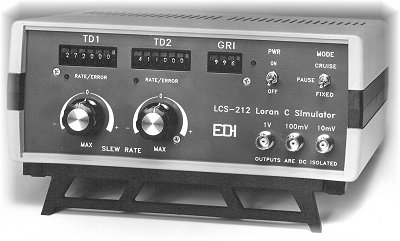
| LCS-212©
EDI's Dynamic Loran C Simulator |
[ Home]
[ Chirp Depth Sounder Test Set]
[ Computer Controlled Depth Sounder Test Set ]
[ Low Frequency Universal Transducer Test Set]
[ Universal Transducer Test Set]
[ Multi Sensor Transducer Test Set ]
[ Computer Controlled Transducer Test Set ]
[ Loran-C Signal Generator ]
[ Downloads]
The LCS-212 dynamic Loran C simulator sets the Loran grid in motion so autopilot interfaces, plotters, and course directors come alive. Slew controls increment the TD's, producing speeds up to several hundred knots. The optional RS-232 interface is perfect for navigation training and ships bridge simulators. One LCS-212 delivers enough signal to drive dozens of loran receivers.

[Features] [Additional Information] [Specifications] [Options]
The LCS-212 produces a Loran C signal composed of a master and two slave groups. The unique slew feature varies the slave TD's to simulate motion, greatly expanding the LCS-212's uses. Not only can you test receivers and isolate antenna coupler problems, you can throughly test plotter, autopilot and other equipment connected to the receiver. When off-the-air signals are not available, the LCS-212 becomes a necessity. The high precision pulse envelope verifies receiver tracking points, and with the optional attenuator, receiver sensitivity and dynamic range can be checked. With the optional RS-232 control package, the LCS-212 becomes a great training aid or component in a ship's bridge simulator system. Open software allows interfacing the LCS-212 with radar, depth, and other navigational simulation gear.
Using the LCS-212 is easy! Select the GRI and slave TD's using the thumb wheel switches on the panel. Connect the Loran receiver directly to the LCS-212's output. There is no need for the coupler, and, because the outputs are DC isolated, no special adapters are required. Once the receiver has acquired the signal, flip the mode switch to cruise, and watch the receiver speed and course readings come alive. Speed and course can be altered by adjusting the slew rate controls. Having the ability to simulate motion makes the LCS-212 a great troubleshooting tool for systems that interface with the NMEA output data. Autopilots, plotters, etc., can be checked for correct response before leaving the dock. The LCS-212 quickly isolates receiver system problems by eliminating the coupler. The entire system, including the coupler can be tested if desired. The signal can be introduced to the coupler by capacitive coupling, or by RF coupling. The optional ACU-1 radiates a 30 volt signal from its 1 meter whip. The range will vary between 20 to one-hundred feet, depending on local noise level or interfering signals. Aircraft receivers can be checked in the hanger, and vehicular tracking systems can be checked in the garage where an off-the-air signal is often not usable.
For precise and repeatable control of speed, course and way points, order the RS-232 option. This option ships with software that will run on any PC. Way points and the transit speed between them may be stored on a file and played back. Navigational training courses can be taught using standard commercial Loran receivers. Several schools have used the LCS-212 as an integral component of bridge simulators.
| Parameter | Range | Resolution | Accuracy |
|---|---|---|---|
| Time base | 10 MHZ internal | N/A | 0.5 ppm1 |
| GRI range | 4990 to 9990 | 100 uS | Time base |
| TD range | 9500 to GRI - 9500 | 0.1 uS | .1uS |
| Slew rate | .005 to .25 uS/GRI | 0.1 uS | N/A |
| Output levels | 10, 100, 1000 mV p-p | N/A | ± 1.5 dB |
| Source impedance | 50W resistive | N/A | ± 5% |
| Output isolation | 40 dB | N/A | ± 3 dB |
| Output DC isolation | 50 VDC Max | N/A | N/A |
| ECD of pulse | N/A | N/A | ± .25 uS2 |
| Output level | 10, 100, 1000mV | N/A | ± 1.0 dB |
| Power requirements: 10-15 VAC or 10-18 VDC @ 400 mA nominal. | |||
| Size and Weight: 10" W by 7"D by 4.5"H. Shipping Wt. 6 Lbs. | |||
|
|||
Please E-Mail edisales@bbginc.com or telephone (757) 366-9211 (within the USA) for more information on EDI's product design services.
Click here to email your questions or comments to EDI.
[ Home ]
[ Chirp Depth Sounder Test Set ]
[ Options for Depth Sounder Test Set ]
[ Loran C Simulator ]
[ Multi-Sensor Transducer Test Set ]
[ Downloads ]
 |
Electronic
Devices, Inc.
1708 South Park Court, Chesapeake, VA 23320. Phone (757) 366-9211 |
Cat LCS-21201/98